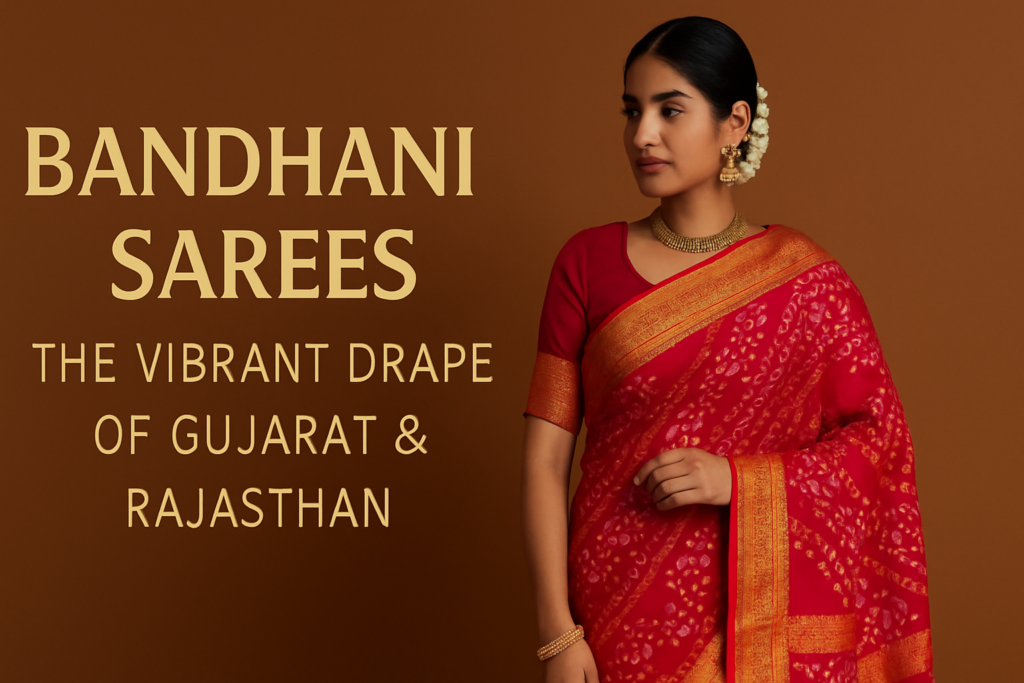
𝗧𝗵𝗲 𝗘𝗻𝗰𝗵𝗮𝗻𝘁𝗶𝗻𝗴 𝗪𝗼𝗿𝗹𝗱 𝗼𝗳 𝗕𝗮𝗻𝗱𝗵𝗮𝗻𝗶 𝗦𝗮𝗿𝗲𝗲𝘀
Originating from the colorful states of Gujarat and Rajasthan, Bandhani sarees are a mesmerizing display of India’s tie-dye tradition. Known for their dotted patterns, vivid color combinations, and airy fabrics, these sarees hold a deep cultural and artistic significance.
✧✧✧
𝗪𝗵𝗮𝘁 𝗶𝘀 𝗮 𝗕𝗮𝗻𝗱𝗵𝗮𝗻𝗶 𝗦𝗮𝗿𝗲𝗲?
Bandhani (or Bandhej) is derived from the Sanskrit word ‘Bandh’, meaning ‘to tie’. This art involves tying small sections of fabric with threads and then dyeing it to create intricate patterns. The result is a saree filled with thousands of colorful dots and shapes, forming stunning geometries and motifs.
✧✧✧
𝗞𝗲𝘆 𝗙𝗲𝗮𝘁𝘂𝗿𝗲𝘀 𝗼𝗳 𝗕𝗮𝗻𝗱𝗵𝗮𝗻𝗶 𝗦𝗮𝗿𝗲𝗲𝘀
🔹 𝗘𝘅𝗾𝘂𝗶𝘀𝗶𝘁𝗲 𝗧𝗶𝗲-𝗗𝘆𝗲 𝗣𝗮𝘁𝘁𝗲𝗿𝗻𝘀
Every Bandhani saree is handmade, ensuring that no two pieces are ever identical. The dots form traditional patterns such as waves, flowers, or jaals (grids).
🔹 𝗧𝗿𝗮𝗱𝗶𝘁𝗶𝗼𝗻𝗮𝗹 𝗠𝗼𝘁𝗶𝗳𝘀
Common Bandhej motifs include Leheriya (waves), Ekdali (single dot), Boond (small dots), and Shikari (hunting scenes) — each with cultural significance.
🔹 𝗩𝗶𝗯𝗿𝗮𝗻𝘁 𝗖𝗼𝗹𝗼𝗿 𝗣𝗮𝗹𝗲𝘁𝘁𝗲
Colors like red, yellow, green, pink, and maroon dominate the palette, each carrying symbolic meaning in regional traditions.
🔹 𝗟𝗶𝗴𝗵𝘁𝘄𝗲𝗶𝗴𝗵𝘁 & 𝗘𝗹𝗲𝗴𝗮𝗻𝘁
Usually made in georgette, chiffon, or cotton, Bandhani sarees are perfect for hot climates and festive wear.
✧✧✧
𝗕𝗮𝗻𝗱𝗵𝗮𝗻𝗶 𝗶𝗻 𝗚𝘂𝗷𝗮𝗿𝗮𝘁 𝗩𝘀. 𝗥𝗮𝗷𝗮𝘀𝘁𝗵𝗮𝗻
While both states practice Bandhani, Rajasthani Bandhej often features finer dots and deeper reds and maroons, whereas Gujarati Bandhani includes brighter hues and larger patterns.
✧✧✧
𝗪𝗵𝘆 𝗘𝘃𝗲𝗿𝘆 𝗪𝗼𝗺𝗮𝗻 𝗦𝗵𝗼𝘂𝗹𝗱 𝗢𝘄𝗻 𝗮 𝗕𝗮𝗻𝗱𝗵𝗮𝗻𝗶 𝗦𝗮𝗿𝗲𝗲
Owning a Bandhani saree is like wearing a piece of folk art. Whether it’s a traditional wedding, Navratri night, or a cultural event, these sarees make a statement. With so many trending bandhej saree designs available online, you can pick styles that match both tradition and modernity.